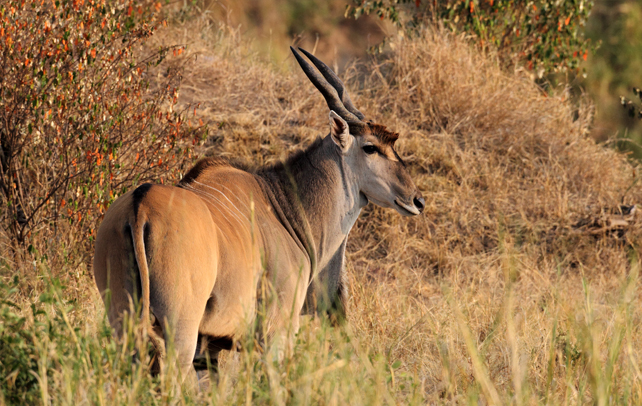Interesting Facts About Eland

Elands are peaceful herbivores which populate the grasslands ofAfrica. These distant cousins of Antelopes once reached the verge of extinction because of excessive hunting for their tasty meat. These meek animals could only moo in protest of such cruelty. Fortunately, their numbers have increased significantly after they were announced a protected species. Elands, though mostly peaceful, exhibit a raging behaviour, specially the males, at the time of competing for leadership of the herd, as well as, for mating the females. This rage even complements their strong built and enormous strength with which they, at times, bring down trees to graze the tender leaves off the upper portions. And it is an altogether different, heart thumping, sight when they run in herds, sometimes to get away from predators and other times for fun, causing waves or ripples of tremors. Whatever said and done, at the end of the day, these splendid creatures are worth knowing about. And the following section will help you with just that. Have a read then!
Fast Facts
Scientific Name: Taurotragus
Kingdom: Animalia
Phylum: Chordata
Class: Mammalia
Order: Artiodactyla
Family: Bovidae
Subfamily: Bovinae
Genus: Taurotragus
Species: Taurotragus Oryx (Common Eland or Southern Eland) & Taurotragus Derbianus (Giant Eland)
Weight: 300 to 600 kg (females) and 450 to 1,000 kg (males)
Diet: Herbivore (grass, branches and leaves)
Age Of Sexual Maturity: 15 to 36 months in females and 4 to 5 years in males
Gestation Period: 9 months
Average Litter Size: 1
Predators: Lion, leopard, hyena, cheetah, cape hunting dog
Average Lifespan: 15 to 20 years (some are known to live as long as 25 years)
Habitat: Eastern & Southern Africa
Interesting And Fun Facts About Eland
- Eland is a species of antelopes, found especially in grasslands of Africa. These creatures have big antlers and are the biggest species of Antelopes found in Africa.
- These giant antelopes stand at a height of two metres at the shoulder and a fully grown adult, on average, can weigh up to seven hundred kilograms, nearly the weight of a small car.
- Almost all the subspecies of these antelopes are endangered and have been announced protected in most parts of Africa. This is the result of uncontrolled hunting of these animals which led to a near extinction of the species. These creatures are hunted for their meat, which is highly nutritive, and hides, which is really expensive.
- In spite of their large size, elands can jump long distances and heights. An adult eland can jump up to a height of eight feet from a standstill.
- Female elands are much smaller when compared to the stags. This makes them much more vulnerable to the predators.
- An eland has large hoofs which give it its peculiar walk and this is the feature which makes it similar to the cattle family.
- Adult males have a thick growth of hair on the forehead which distinguishes them apart from the females of the species. These hairs grow thicker with age.
- This coat changes its colour with age and time. It is tan-ish in colour when they’re young, and turns bluish-grey as they age. At times, the coat turns into a dark black colour when an eland grows really old.
- The males of this species also have a unique feature called dewlap. It is a continuous piece of loose skin which hangs from their neck and has a tuft of thick black hair growing from it.
- The most impressive part of an eland’s anatomy is its horns, which can grow up to three feet in length. In elands, it is the females that have longer but much delicate than horns that of the males.
- Elands have been observed to be more active in the morning and early evening. It’s because of the region they inhabit—Africa—which is piercingly hot at noon. Elands spend this time sheltered under trees or in bushes.
- Though belonging to a family of sprinters, elands are much slower when it comes to running. In facts, they are said to be the slowest of all antelopes. They cannot sprint but can surely maintain a trot for a much longer time.
- The females of this species of antelope reach sexual maturity at the age of three years and start mating from that time. Males on the other hand reach sexual maturity at the age of 4 to 5 years.
- There is no particular mating season which these creatures follow but for obvious reasons, they prefer giving birth to the offspring before rains. As during rains it is difficult for the newborn to survive. Plus, rains provide the newborns with lush green grass to feed on.
- The average litter size of these animals is one per year but it is not really uncommon for these animals to have twins. Calves survive totally on mother’s milk for three months, after which they are typically weaned in the fourth month of their birth.
- As these animals are sociable in nature, they live in large groups containing anywhere between 25 to 70 elands. In some parts of Africa, a herd with as many as 400 elands has also been observed.
- There is a particular nursery for all the newborns. The mother and the newborn calf stay at the nursery after birth, but as the calf is three years old, both mother and the calf join the herd. The security of the nursery depends on the females of the herd which form the nursery.
- There have been attempts to domesticate these wild beasts as both their milk and meat is highly nutritious and of great value in the market too. And as a matter of fact, they have been semi-domesticated in some areas.
- The average lifespan of an eland in wild is 15 to 20 years which is quite low. However, some are known to live as long as 25 years, following healthy diet and dodging natural predators.









